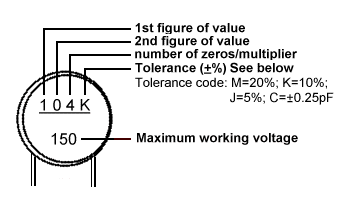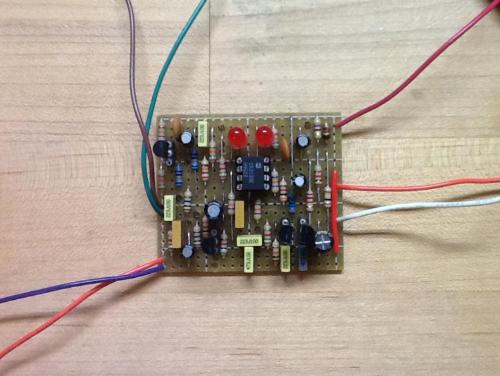Capacitor Quesition
|
Hey,
I was wondering if someone could clear up a bit of confusion up for me, On most layouts there seems to be 3 types of cap, lower value yellow caps, mid value red caps, and high value circular caps. I was just wondering what specific type of cap should be used for what value, for example a lot of capacitor kits on eBay have a value ranges that cross over, example there are multi layer caps that go well in the greenie cap value territory, and some greenies that are as high as electrolytic value. Is there a rule of thumb as to what type of cap to use for specific value ranges, or will any cap essentially do the same thing? on the layouts do the smaller yellow ones mean use multi-layer ceramic, the mid range red ones mean use greenie capacitors, and then the big circular ones mean use electrolytic caps. Any help would be really great! Eric |
|
As a rule of thumb (as I learned from the great folks here)
1-999 pF - Generally we get Ceramic Caps. Sometimes you can find film caps in this range, but you're good with small ceramic caps. Get pin spacing of either 2.54 or 5mm. 1nF-1uF - Film caps. We like to use box film caps. You can also get chicklet style caps, but film caps are pretty common and easy to find. You should be looking for pin spacing of 5mm, and voltages of 25-100V. 1uF-220uF - You will be looking at Aluminum Electrolytic capacitors, radial, of a diameter of 5mm where possible, and 6.3mm for 100uF and higher. pF - ceramic caps nF - box/film caps uF - electrolytic caps. AND, see this thread too!! http://guitar-fx-layouts.42897.x6.nabble.com/Question-When-to-use-a-box-cap-over-a-film-cap-td13820.html Cheers!
Yeah, 220, 221. Whatever it takes.
|
|
Just to add to the above.
The info provided by Chris is a very good general guide, but there is no rule on which type to use when. For instance multilayer ceramics up to 1uF and can be useful where space is tight. A lot will depend upon what you have available in your stash. |
|
Administrator
|
and just to add on to what has been said. with electrolytics, when you see them on the layout there's a white line on one side, and none on the other. the white line indicates the negative end of the electrolytic cap, and need to be placed in the correct orientation to work right.
also, the colors that appear in the layouts seem to be matched to the parts a lot of us use. if you look at most ceramics, they are yellowish in color, as are the multilayer ceramics dbat mentioned. the red is usually poly/mylar caps, and a lot of us use the panasonic brand ecq caps, which are read, but you will also find cheap ones in green, which we usually call greenies. finally if you look at electrolytic caps, a lot of them are blue/black with a white/grey stripe on the negative end. so the idea is that the layout colors and shapes indicate the way they look in reality. btw, nothing wrong with greenies, the issues is that they can get very big as capacitance increases, where as the panasonic ones keep a relatively consistent size. others, also use the box caps, but they are usually more expensive then both greenies and the panasonic. |
|
Awesome, thanks a million for all the info, thats certainly cleared things up for me. I reckon I'll just buy a multi-layer set, greenie set, and electrolytic set and go from there! Although I do like the look of the box caps.......
 
|
|
This post was updated on .
Just to add a few more comments to the excellent advice given above - I like box caps. A lot. You can get them from 1 - 1000 nF and they fit very neatly in most all layouts (see below). One thing about the greenies is that in the higher values (47 nF and above) they can get really fat! And that can make them more troublesome to install.
Likewise for electrolytic capacitors. Try to get the smallest voltage ratings you can (e.g. 35V or 50V). Otherwise, they can get big too. Notice in the photo that the electrolytics are smaller and fit neatly. Sometimes, vero layouts have the electros next to other components and they can be a pain to fit in without sticking up too high. And remember that the height of the tallest component is what limits you when it comes to boxing. Shorter is better!  By the way, box caps (and other capacitors) have tolerance like resistors. You'll see a letter associated with this: J=5%, K=10%, M=20%. I try to get 5% tolerance, but 10% are probably OK unless you're really picky. The capacitor codes printed on most caps is given below. The number represents the value in pF (e.g. code 104 = 10 x 10^4 = 10^5 pF = 100 nF).  Finally, what about price? I've been looking for bargains on eBay and the major online suppliers. What I've found is that you should be able to get good quality caps for about 20 cents or less (perhaps much less) a piece. The problem is that it seems sellers want you either to buy 5 or 500! I'm not sure I need 500 10 nF caps, but... Assortments are a good way to start, but eventually you will want to stock up on the values you need the most (for me 1, 4.7, 10, 22, 47, 100 nF go quickly). Good luck! 
|
|
Awesome thanks a lot, thats a lot of really helpful advice. I've been thinking of buying a few capacitor sets on eBay, so far I narrowed it down to this set of multi-layer ceramic caps:
http://www.ebay.ie/itm/281428555568?ssPageName=STRK:MESINDXX:IT&_trksid=p3984.m1436.l2649 And this set of greenies: http://www.ebay.ie/itm/321054905813?ssPageName=STRK:MESINDXX:IT&_trksid=p3984.m1436.l2649 Any suggestions for some box cap sets, or electrolytic sets? Thanks again P.S: those WIMA box caps look very cool! |
|
Administrator
|
Both of those should be fine. Check over under the bargains thread. I know there's been area posts about good cheap cap and resistor sets. I know I posted a few, but don't recall them at this moment. If you can, and there's not a big import tax or anything checkout taydaelectronics. I get all my normal caps dirt cheap, pots, enclosures, resistors, LEDs, etc. there especially when there's a 20% coupon. Once you know the stuff you run out of first, like resistors and electrolytics you can just order a boatload for cheap.
|
|
In reply to this post by eric90000
Dr. Tweek in the UK has a pretty good range of poly box, wima, and electro caps, at pretty good prices.
Worth checking out the electros, as they are very small, so can fit in the tightest spaces. Wimas on the other hand can sometimes not fit as they tend to be quite wide - a lot wider than the poly box caps. Break out the multilayers if you really struggle to get anything else to fit. Get a bunch of everthing - you can't really go wrong with caps. EDIT: Axial MMC's - get an assortment pack of those too, perfect for large spans. |
|
In reply to this post by eric90000
I just got that same set of polycarbonate caps off of ebay but I have not used them yet. They are very small, even up to values of 10uf - with no polarity. I am curious to see how they work. They are said to be very good except in one aspect - tolerance levels which can be between 10 and 20%.
But it is a good thing that you get some 1uf and even 10uf caps without polarity because they are actually quite few circuits here that call for them. All I had were electrolytics so I had to find out which way the ground was supposed to go (there is a rule - but you need to read the voltage on both sides of the potential cap placement) - suffice it to say, it is just easier to go with the non-polarized caps when you see them in a circuit. Most people prefer the larger box or polypropylene caps - they do look better, can withstand much more voltage (just in case, although you should rarely need it in a guitar effect) and have a tighter tolerance. But they usually top out a 68n - not up to 1 uf. If you want them in higher values you usually have to buy them in separate lots (I did, anyway). Greenies are good, but they are tall and can get pretty fat - taking up a lot of room. So, like you I will be trying out the polycarbonate to see how they work - they are cheap, small and diverse in ranges. But I also have plenty of box and even tantalum caps as backups just in case. By the way - here is a trick. When you see a cap using this notation "10n" (very common here), just think of the n as 3 zeros, so that is a 10,000 nanofarad cap, which will have the notation 103. If it says 1n, the notation will be 102 (1 followed by 3 zeroes). If it says 6n8 it is 6.8 nanofarads, meaning the value code will be 682 (the number after the n took one of the zeroes). |
«
Return to Open Chat
|
1 view|%1 views
| Free forum by Nabble | Edit this page |

